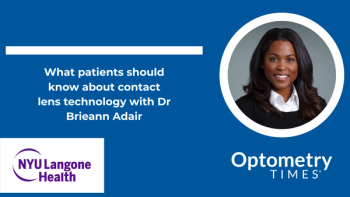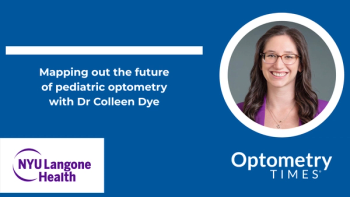
Supporting eye health through a holistic approach to full-body health
Our patients benefit from a preventive approach that includes lifestyle adjustment, nutrition, and supplementation.
Eyes are an integral part of overall health. As we provide eye care, we must also consider full-body health, making sure we treat patients holistically. As we do so, I believe it is our job to focus on prevention, helping patients to act in ways today that will minimize their burden in the future.
During an eye exam, we have the opportunity not only to assess eye health but also to detect various diseases that are not primarily eye conditions. I have most commonly identified diabetes and hypertension, but it is also possible to detect other cardiovascular conditions, as well as autoimmune diseases, neurodegenerative disorders, and infectious diseases.1 These diagnoses can be made noninvasively, and they can come early in the disease progression.
Annual exams are important for this kind of evaluation, and we must emphasize to patients that the exams are about more than vision. When we have patients in the chair, it is also a good opportunity to educate them about the elements of lifestyle, nutrition, and supplementation that are central to holistic health.
When I have a patient in the exam chair, I begin by asking questions. How much sleep are they getting? What are their eating habits? If they have diabetes or high blood pressure, I want to know their glycated hemoglobin levels or their blood pressure.
I let patients know there are tests that can be done to measure factors generally not included in a traditional health screening panel. These tests can be performed by a functional medicine doctor, and, in some states, certain lab tests can also be done at home via home kits. These tests can provide information about digestive health, genetic factors, oxidative stress markers, organic acid levels, food intolerances, toxin levels, and hormonal balance. Unfortunately, I also have to tell patients that these tests are usually not covered by insurance, and patients often choose not to get them.
During the visit, I talk about lifestyle choices, trying to carefully ease patients in a healthier direction. If I have a patient who smokes 10 cigarettes a day, for example, I will usually ask them whether this is the norm or whether they have been cutting back. I find this question opens their mind a bit.
I will then ask them whether they can cut down to maybe 7 cigarettes a day. Some might ask what the point is of this reduction, since the patient will still be smoking. But it is the beginning of a change—the beginning of developing new habits, which is one of the hardest things to do.
The importance of nutrition
I always discuss nutrition with patients. We know that nutrition plays a crucial role in eye health. Vitamins C and E, zinc, lutein, zeaxanthin, and ω-3 fatty acids have been linked to reduced risks of age-related macular degeneration (AMD) and other ocular diseases.2,3 Antioxidants have been shown to protect against oxidative stress, and carotenoids support retinal integrity.4 Nutrition also affects overall health, which then further affects eye health.
When discussing nutrition, I also begin with questions. “What types of fruits and vegetables are you eating and how often? What drinks are you consuming?” I tend to ask open-ended questions vs questions that will elicit a yes-or-no response. Habits and trade-offs play a large role in nutrition.
I usually give patients a cheat sheet that describes different nutrients and how they relate to the eye. I encourage them to get as many vitamins and nutrients as possible from their food. Some patients simply are not going to make the necessary dietary changes, however, and I find that it can be hard for even those who eat well to get the necessary nutrients, due to gut and genetic factors as well as changes in the nutrient values of crops.
The complexity of supplementation
For this reason, I often recommend (or “prescribe”) supplements. Education in this area can be tricky. Patients usually come to us having been exposed to some information about supplements, and that information is generally incomplete and sometimes false. There are many myths circulated on social media and among family and friends. It is our responsibility to both educate patients and recommend certain quality products.
Some patients hear that they should be taking vitamin B12, for example, and then they take a B12 supplement that does not contain vitamin B6. I let them know that B6 is necessary for the absorption of B12 and that they need to be taking a supplement that combines these vitamins.
Supplements often contain specific formulations, and here it is important to recommend products that contain not only quality ingredients but also the proper concentrations of those ingredients.
When possible, I look for formulations that are based on clinical research. The Age-Related Eye Disease Study (AREDS)5 study, for example, found that a formulation containing high doses of the antioxidants vitamin C, vitamin E, and beta carotene and the minerals zinc and copper reduced the risk of progressing to advanced AMD by about 25% in individuals with intermediate or advanced AMD. AREDS2 then demonstrated that replacing beta carotene with lutein and zeaxanthin maintained the protective effect against advanced AMD and reduced the risk of lung cancer associated with high-dose beta carotene intake by current or former smokers.6 I want my patients to take a supplement that closely follows these findings, such as MacularProtect Complete (ScienceBased Health).
Dry eye syndrome
Patients often come to me with dry eyes. There are many factors, including allergies, contact lens use, extensive screen use, and lack of sleep, as well as conditions such as meibomian gland disease, that lead dry eye to be one of the main complaints we field as optometrists. I see the condition affecting my patients’ work, sleep, and quality of life.
This is an example of a situation in which overall health affects the eyes, and eye health then also affects other elements of health. In the case of dry eye disease, for example, several studies have suggested that treating dry eye can lead to better sleep quality and reduced symptoms of anxiety and depression.7-9 Managing dry eye also results in more stable vision, and better vision has been associated with a reduced risk of falls and fractures in older adults.10,11
To manage dry eye syndrome, I always talk to my patients about diet and lifestyle adjustments, since food is our natural medicine. I will typically recommend vitamin C in the form of foods such as brussels sprouts, broccoli, or peppers, since vitamin C helps to maintain a functional tear film.12 Vitamin A typically helps with the front surface of the eye, so eating sweet potatoes or carrots is helpful.13 Since lutein and zeaxanthin are helpful for the macula, green leafy vegetables such as kale or spinach and pasture-raised eggs are high on the list. The most obvious choice would be to consume a lot of water, since our bodies are made up mostly of water. To add a little bit more coverage, I would recommend either Retaine (OCuSOFT) or Systane Complete (Alcon) to use as artificial tears.
I also take a holistic approach and recommend a nutraceutical to help combat inflammation. Here too, I prefer a clinically proven formulation. HydroEye (ScienceBased Health) contains gamma-linolenic acid, a healthy ω-6 fatty acid that has been shown to reduce inflammation,14,15 combined with ω-3 fatty acids as well as nutrient cofactors. This combination has been found to be effective in a double-blind, randomized, multicenter, controlled trial.16
The gut microbiome
Once patients are consuming the necessary range and amount of nutrients, their bodies must also absorb adequate quantities. The gut plays a vital role in nutrient metabolism, as it does in modulating immune response and in inflammation control. A healthy gut microbiota can reduce the risk of ocular diseases such as uveitis and AMD,15 while gut dysbiosis can lead to systemic inflammation and contribute to eye conditions such as dry eye syndrome and retinal disorders.17
We must educate our patients about choices that will benefit their gut microbiome. The microbiome will benefit from fruits, vegetables, and whole grains rich in prebiotic fiber18,19; fermented foods18; physical activity20; adequate hydration18; and limiting processed foods and added sugars.19 Improving nutrient uptake will amply the benefits of good nutrition and supplementation, benefiting the eyes as well as full-body health.
Conclusion
Eye health is closely connected to overall health, and we must support our patients with a holistic approach to eye care. Through lifestyle changes, nutrition, and smart use of supplements, we can improve our patients’ eye health as well as their general health and quality of life. Regular clinic visits are an important part of holistic, preventive care, allowing us an opportunity to provide education in addition to diagnosis and treatment.
References:
Kumar MJ Jr, Kotak PS, Acharya S, Nelakuditi M, Parepalli A. A comprehensive review of ocular manifestations in systemic diseases. Cureus. 2024;16(7):e65693. doi:10.7759/cureus.65693
Rasmussen HM, Johnson EJ. Nutrients for the aging eye. Clin Interv Aging. 2013;8:741-748. doi:10.2147/CIA.S45399
Lawrenson JG, Downie LE. Nutrition and eye health. Nutrients. 2019;11(9):2123. doi:10.3390/nu11092123
Das S, Roy S. The role of nutrition in eye health: a comprehensive review. J Popul Ther Clin Pharmacol. 2024;31(6):1281-1286. doi:10.53555/jptcp.v31i6.6667
Age-Related Eye Disease Study Research Group. A randomized, placebo-controlled, clinical trial of high-dose supplementation with vitamins C and E, beta carotene, and zinc for age-related macular degeneration and vision loss: AREDS report no. 8. Arch Ophthalmol. 2001;119(10):1417-1436. doi:10.1001/archopht.119.10.1417
Age-Related Eye Disease Study 2 Research Group. Lutein + zeaxanthin and omega-3 fatty acids for age-related macular degeneration: the Age-Related Eye Disease Study 2 (AREDS2) randomized clinical trial. JAMA. 2013;309(19):2005-2015. doi:10.1001/jama.2013.4997
Ayaki M, Kawashima M, Negishi K, Tsubota K. High prevalence of sleep and mood disorders in dry eye patients: survey of 1,000 eye clinic visitors. Neuropsychiatr Dis Treat. 2015;11:889-894. doi:10.2147/NDT.S81515
Uchino M, Schaumberg DA. Dry eye disease: impact on quality of life and vision. Curr Ophthalmol Rep. 2013;1(2):51-57. doi:10.1007/s40135-013-0009-1
Kawashima M, Uchino M, Yokoi N, et al. The association of sleep quality with dry eye disease: the Osaka study. Clin Ophthalmol. 2016;10:1015-1021. doi:10.2147/OPTH.S99620
Hong T, Mitchell P, Burlutsky G, Samarawickrama C, Wang JJ. Visual impairment and the incidence of falls and fractures among older people: longitudinal findings from the Blue Mountains Eye Study. Invest Ophthalmol Vis Sci. 2014;55(11):7589-7593. doi:10.1167/iovs.14-14262
Ivers RQ, Cumming RG, Mitchell P, Attebo K. Visual impairment and falls in older adults: the Blue Mountains Eye Study. J Am Geriatr Soc. 1998;46(1):58-64. doi:10.1111/j.1532-5415.1998.tb01014.x
Shetty R, Khamar P, Sethu S. The role of vitamins in ocular surface diseases. CRST Global. May/June 2024. Accessed March 9, 2025. https://crstodayeurope.com/articles/may-june-2024/the-role-of-vitamins-in-ocular-surface-diseases/
Ge H, Di G, Song P, Han W, Chen P, Wang Y. Role of vitamin A on the ocular surface. Exp Eye Res. 2025;250:110179. doi:10.1016/j.exer.2024.110179
Kapoor R, Huang YS. Gamma linolenic acid: an antiinflammatory omega-6 fatty acid. Curr Pharm Biotechnol. 2006;7(6):531-534. doi:10.2174/138920106779116874
Macrì A, Giuffrida S, Amico V, Lester M, Traverso CE. Effect of linoleic acid and gamma-linolenic acid on tear production, tear clearance and on the ocular surface after photorefractive keratectomy. Graefes Arch Clin Exp Ophthalmol. 2003;241(7):561-566. doi:10.1007/s00417-003-0685-x
Sheppard JD Jr, Singh R, McClellan AJ, et al. Long-term supplementation with n-6 and n-3 PUFAs improves moderate-to-severe keratoconjunctivitis sicca: a randomized double-blind clinical trial. Cornea. 2013;32(10):1297-1304. doi:10.1097/ICO.0b013e318299549c
Campagnoli LIM, Varesi A, Barbieri A, Marchesi N, Pascale A. Targeting the gut-eye axis: an emerging strategy to face ocular diseases. Int J Mol Sci. 2023;24(17):13338. doi:10.3390/ijms241713338
Napolitano P, Filippelli M, Davinelli S, Bartollino S, dell’Omo R, Costagliola C. Influence of gut microbiota on eye diseases: an overview. Ann Med. 2021;53(1):750-761. doi:10.1080/07853890.2021.1925150
Ghosh TS, Valdes AM. Evidence for clinical interventions targeting the gut microbiome in cardiometabolic disease. BMJ. 2023;383:e075180. doi:10.1136/bmj-2023-075180
Hills RD Jr, Pontefract BA, Mishcon HR, Black CA, Sutton SC, Theberge CR. Gut microbiome: profound implications for diet and disease. Nutrients. 2019;11(7):1613. doi:10.3390/nu11071613
Newsletter
Want more insights like this? Subscribe to Optometry Times and get clinical pearls and practice tips delivered straight to your inbox.



















































.png)


